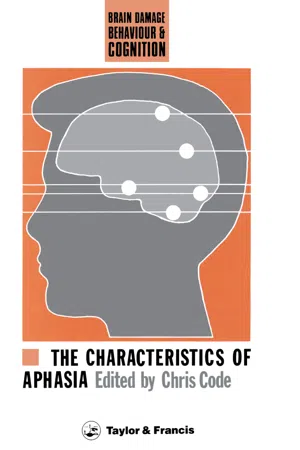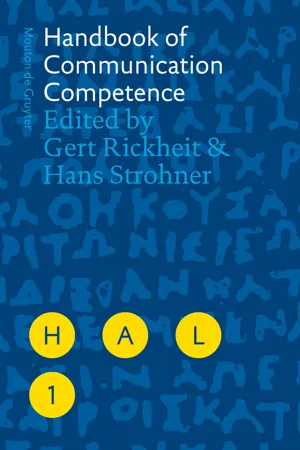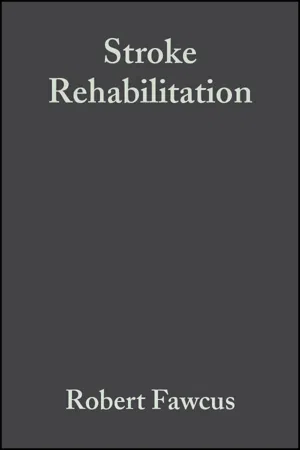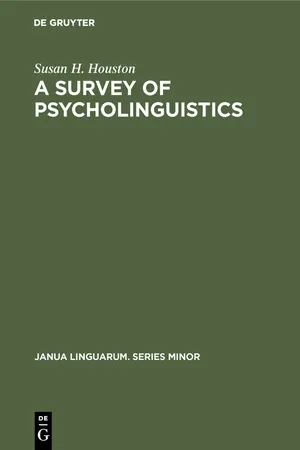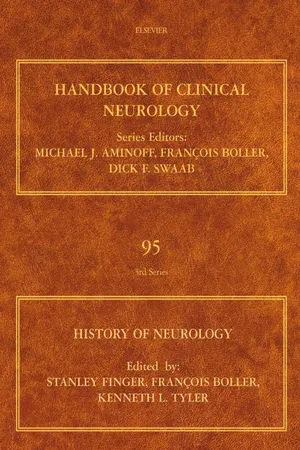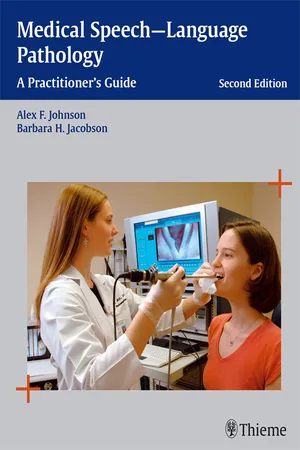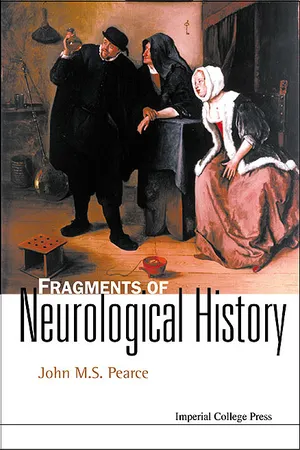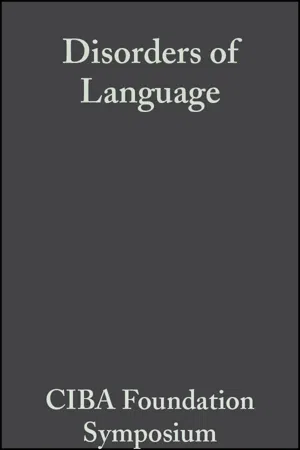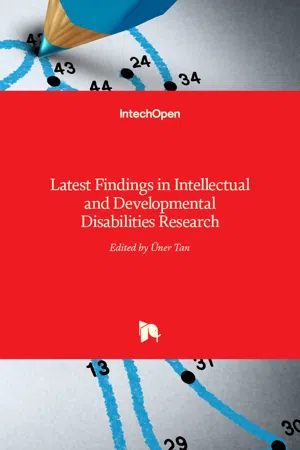Languages & Linguistics
Aphasia
Aphasia is a language disorder that affects a person's ability to communicate. It is typically caused by damage to the brain, often resulting from a stroke or head injury. Individuals with aphasia may have difficulty speaking, understanding language, reading, and writing, but the specific symptoms can vary depending on the type and severity of the condition.
Written by Perlego with AI-assistance
Related key terms
1 of 5
12 Key excerpts on "Aphasia"
- Louise Cummings(Author)
- 2013(Publication Date)
- Cambridge University Press(Publisher)
Accordingly, Aphasia can provide useful information about the neural basis of language and about the way different modes of language use (e.g. naming of objects, comprehension of written sentences) are organized in the brain. Aphasia 225 13.2 Aphasia: some background 13.2.1 Definition of Aphasia Aphasia is a disorder in the production and comprehension of spoken and written language. It is caused by a unilateral localized brain lesion in individuals who had normal language development. Several features of this definition of Aphasia are noteworthy. The first is that Aphasia is a language disorder. In this chapter, the expression ‘lan- guage disorder’ is used to show that Aphasia is a central deficit affect- ing both comprehension and production and both spoken and written language. Defining Aphasia as a language disorder distinguishes it from articulation disorders, such as dysarthria (a motor speech disorder; see Chapter 11, this volume) and apraxia of speech (a disorder in program- ming and monitoring articulation, see Chapter 12, this volume). Such disorders often accompany Aphasia, but can also occur without apha- sia. Brain damage may affect articulatory abilities, for example, because the motor area is affected. In such cases, the person will display speech problems (a dysarthria). However, he or she will still be able to write and to understand both spoken and written language, because the language system itself is intact. Also, disorders in auditory and visual perception due to brain damage are excluded by this definition. Such disorders may result in auditory comprehension or reading problems, but these are not the consequence of a language disorder. Communication disorders as a result of dementia are also excluded by this definition of Aphasia. This is because there is no unilateral brain lesion and the language problems in dementia are progressive (see Chapter 15, this volume).- eBook - PDF
- Chris Code(Author)
- 1989(Publication Date)
- CRC Press(Publisher)
As the systematic and scientific study of language gave rise to the development of linguistic description and explanation, then other disciplines -linguistics and psycholinguistics -brought different ideas and methodology to the breakdown of language as represented by Aphasia. Aphasia therapy is perhaps the best developed area of neuropsychological rehabilitation, and speech pathology has developed foundations for assessment and treatment over the years derived to a large extent from theoretical and empirical progress. The area is fraught with controversy and has been during the entirety of its history. Over 130 years of study has resulted in a massive literature on 1 The Characteristics of Aphasia Aphasia and currently it is coming in for intense investigation from several scientific directions. As with all phenomena, there are a number of ways of looking at Aphasia. Also as with other phenomena, the way something is looked at, the perspective that is taken, in itself not only increases our under-standing of phenomena, but can also limit it. Having one window on some-thing brings some details into sharper focus but often obscures an alternative or complementary view. One way to approach Aphasia is to adopt the general assumption that it results from impairment in the use of those features of human language which can be characterized through a formal unit-and-rule generative linguistic model. In Aphasia the patient has problems which can be described in terms of the representational linguistic levels of phonology, morphology, syntax and lexical semantics. But while there may be good reasons to assume that Aphasia represents pure linguistic breakdown, there are acquired communi-cation impairments where it is less clear whether the underlying disorder is specifically linguistic in nature. - eBook - PDF
- Gert Rickheit, Hans Strohner, Gert Rickheit, Hans Strohner(Authors)
- 2008(Publication Date)
- De Gruyter Mouton(Publisher)
16. Language disorders Martina Hielscher-Fastabend Acquired language and communication impairments can result from brain da-mage of various neurological etiology. Of course, the most intriguing disorder concerning language skills in adults is Aphasia. Aphasia has to be contrasted to other language and speech problems caused by brain damage, for example lesions of the right hemisphere or frontal lobes on the one hand and the dysarth-rias and speech apraxia on the other hand. Usually, patients suffering from Aphasia have problems with auditory / oral language as well as with written lan-guage in perception and production. Quite often problems are more severe in the productive than in the perceptive mode. But depending on the area and ex-tent of the lesion site, some patients may be able to speak but not write or vice versa, and some patients have even more severe problems with auditory com-prehension than with reading or with language production. This chapter first gives a short introduction followed, second, by an over-view on the basic brain mechanisms of language functions. In the third part we begin with the traditional classification of Aphasia which is closely related to neurobiological questions of lesion site. This general section is followed by the neurolinguistic approach and a communicative perspective to describe symp-toms, diagnostic tools and therapeutic methods. - eBook - PDF
Stroke Rehabilitation
A Collaborative Approach
- Robert Fawcus(Author)
- 2008(Publication Date)
- Wiley-Blackwell(Publisher)
Chapter 7 Speech and Language Problems Following Stroke Jane Marshall Dysphasia Dysphasia, or Aphasia, is a language disorder arising from neurological impair-ment, usually as a result of damage in the left side of the brain. However, there are rare cases arising from right sided lesions (sometimes termed `crossed Aphasia'). Approximately 30% of stroke patients acquire a lasting dysphasia (Bonita & Anderson, 1983). Technically, Aphasia means total loss of language and dysphasia partial loss. However, the terms tend to be used interchangeably. Dysphasia impairs all aspects of language, e.g. speech production, compre-hension, reading and writing; it may also affect the person's gestures and the use of drawing to communicate. Dysphasia is different from general cognitive impairment and does not interfere with the person's ability to plan their lives, have opinions, remember, think and imagine ± as can be demonstrated by non-verbal tests of memory and reasoning. One of the most puzzling features of dysphasia is its extreme variability, both in terms of the severity and nature of the disorder, as illustrated in Table 7.1. Speaker 1 has a particular difficulty thinking of the words he wants to use, although is speech is grammatical. He has anomia , a word finding problem, and has a number of strategies to help overcome this problem: he can draw his ideas or use gestures and carry on a conversation. Although he often cannot produce words independently, he can repeat them; so when the therapist says `navy', he repeats this word in response. Speaker 2 accesses key nouns more successfully than the first speaker. How-ever, her speech almost completely lacks grammar or is agrammatic : there are no sentences, few grammatical words (like `is' and `of') and no verbs. She is good at listing objects, but very poor at conveying what she has been doing; she seems quite good at understanding sentences even though she cannot produce appro-priate responses to the therapist's questions. - eBook - PDF
- Susan H. Houston(Author)
- 2019(Publication Date)
- De Gruyter Mouton(Publisher)
Aphasia AND OTHER LANGUAGE PATHOLOGIES 253 Although one can specify those disorders which do not belong under the heading of Aphasia, it is somewhat more difficult to describe precisely what type of loss has occurred in a particular case. For this reason among others, it has proved nearly im-possible for all practical purposes to create an orderly and con-sistent typology or taxonomy of aphasic disturbance. One prob-lem is that brain damage may be either localized or more gener-alized, and either sort can have a notable effect on language abilities. Theoretical description would be simplified if language could be conceptualized as a localized unit controlled by one portion of the brain; there is, however, little evidence to support such a notion since general brain damage may cause some loss of linguistic ability even when not concentrated in one of the sup-posed speech areas. Additionally there is rarely a case in which language impairment is the only symptom, so that there is no set method of predicting what type of loss will occur from most specific types of injury, nor of extrapolating the nature and extent of injury from observation of the language impairment. The most frequent cause of severe language disfunction is extensive injury to the dominant (usually the left) cortical hemisphere, but this too has its exceptions (cf. Lenneberg, 1967, pp. 57-67). There have been many attempts to form a classificatory system of language disabilities, since being able to state which of a finite number of disorders is manifested by a particular aphasic patient would be useful both in predicting what sort of behavior he is likely to demonstrate and in indicating possible directions of treatment or training. - eBook - PDF
- Stanley Finger, Francois Boller, Kenneth L. Tyler(Authors)
- 2009(Publication Date)
- Elsevier(Publisher)
Chapter 36 History of Aphasia: from brain to language PAUL ELING 1 * AND HARRY WHITAKER 2 1 Department of Psychology, Radboud University Nijmegen, Nijmegen, The Netherlands 2 Department of Psychology, Northern Michigan University, Marquette, MI, USA INTRODUCTION Until the latter half of the 20th century, the study of Aphasia was mainly performed by physicians and rarely addressed by students of language; Chajim Steinthal (1823–1893) and Roman Jakobson (1896–1982) are nota-ble exceptions (see also De Bleser, 2006). Steinthal’s plea for a psycholinguistic approach to Aphasia was ostensibly ignored by the medical establishment (Jacyna, 1999; Eling, 2006a), although one should point out that the neurologists John Hughlings Jackson (1835–1911) and Arnold Pick (1851–1924) adopted prin-ciples of linguistic analysis in their studies of Aphasia. On the other hand, the study of language disorders has always played a dominant role in attempts to understand the biological basis of the mind. The dominant view on the origin of languages held by the Egyptians and Babylonians was that the Gods gave the language faculty to mankind. A clay fragment from the Hittite period (c. 1500 BCE) described an epi-sode in the life of King Mursilis II. While driving his chariot in a thunderstorm, he lost his speech. Mursilis blamed this event on the storm god, and burned his clothes, the chariot, and the horse in an effort to appease the angry god. The king’s recovery was attrib-uted to the successful sacrifices, rather than to what was perhaps a transient ischemic attack (Whitaker, 1998). Other common themes in the early texts on lan-guage were that thinking was conceived of as speaking to oneself, and that naming a thing is necessary in order for it to exist (Lutz, 1936). The vast majority of the old texts concerned language production, i.e., articulate speech; comprehension was not considered a separate faculty until the latter part of the 19th cen-tury (Boller, 1978; Whitaker, 1998). - eBook - PDF
Contributions to Comparative Mythology
Studies in Linguistics and Philology, 1972-1982
- Stephen Rudy(Author)
- 2010(Publication Date)
- De Gruyter Mouton(Publisher)
ON APHASIC DISORDERS FROM A LINGUISTIC ANGLE Apres tout, c 'est ainsi que nous communiquons, par des phrases, meme tronquees, embryonnaires, incompletes, mais toujourspar des phrases. C'est id, dans notre analyse, un point crucial. — Emile Benveniste 3 septembre 1966 1 Over three decades ago, in 1941, when I was about to publish my first study dealing with Aphasia, Child Language, Aphasia, and Phonological Universals, 2 I was surprised at the extent to which linguists neglected questions concerning children's acquisition and pathological disruptions of language. In particular, the field of Aphasia was usually disregarded. There were, however, a few neurologists and psychologists who insisted on the important role that linguistics can play in this domain. They realized that Aphasia is first and foremost a disintegration of language, and as linguists deal with language, it is linguists who have to tell us what the exact nature of these diverse disintegrations is. Such were the questions raised, for instance, by A. Pick, A. Gelb, K. Goldstein, and M. Isserlin. 3 But among linguists themselves there reigned a total indifference to problems of Aphasia. Of course, as always, one can find exceptions. Thus from the early 1870's, one of the greatest precursors of modern linguistics, Jan Baudouin de Courtenay, consistently observed and investigated cases of Aphasia and in 1885 devoted to one of them a detailed Polish monograph, From the Pathology and Embryology of Language* which was supposed to be followed by further papers. This study combines a rich and careful collection of data with an emphasis on 1 £ Benveniste, La forme et le sens dans le langage, Problemes de linguistique generate 2 (Paris, 1974), 121. 2 R. Jakobson, Child Language, Aphasia and Phonological Universals (The Hague: Mouton, 1968), translated from the German original of 1941 (cf. Selected Vritings I, 328-401). 3 Cf. A. Pick, Aphasie und Linguistik, Germanisch-romanische Monatsschrift 8 (1920); A. - eBook - PDF
Medical Speech-Language Pathology
A Practitioner's Guide
- Alex F. Johnson, Barbara H. Jacobson(Authors)
- 2011(Publication Date)
- Thieme(Publisher)
strategies. Intervention would focus on personally relevant contexts such as golfing, work, or softball league. Prognosis generation Prognosis would be focused on Prognosis would be focused on initial Prognosis would emphasize the typical recovery patterns of response to treatment and the nature Mr. A.’s motivation and his individuals with Broca’s Aphasia. and extent of the damage to the adaptation to disability, as well language system. as his level of social support. ICF, International Classification of Functioning, Disability, and Health. Disorder-Specific Considerations To effectively conduct assessments in Aphasia, we must be familiar with neurophysiologic underpinnings and correlates, cognitive-linguistic foundations, life-span issues, and socio-cultural concerns. Neuroanatomic/Neurophysiologic Considerations Aphasia is the result of a stroke, head injury, or degenerative condition of the brain. The etiology of the Aphasia may affect the prognosis and may also create other important assessment considerations owing to comorbidities or related disabilities. When Aphasia is the result of stroke or head injury, there is an expectation that continuous improvement will character-ize the course over time. Approximately one third of all adults who have had a stroke experience Aphasia (Laska, Hellblom, Murray, Kahan, & Von Arbin, 2001). Only 20% of adults with head injury have a language disorder that fits the classic crite-ria of Aphasia (Sarno, Buonaguro & Levita, 1987). Primary pro-gressive Aphasia or Aphasia due to other degenerative disease results in deterioration over time. For the traumatic Aphasias, time post-onset is an important factor in prognosis and in the determination of the type and nature of the intervention. It is generally accepted that the acute period of recovery extends from the time of the event to about 3 months post-onset. - eBook - PDF
- John M S Pearce(Author)
- 2003(Publication Date)
- ICP(Publisher)
Aspects of cerebral disorders This page is intentionally left blank 14 Aphasia or aphemia I remember reading about the ancient use of tiie word aphemia instead of Aphasia when a young student. Aphemia, I felt, was a mellifluent, romantic word and I wondered about its origin. Trousseau, in his seventh lecture given at the Hotel-Dieu, Paris, On Aphasia, gives an interesting footnote 1 : The affection which I am about to describe was, in 1841, termed alalia by Professor Lordat; and in 1861, Mr Broca changed this name for that of aphemia. But Mr Chrysaphis, a very distinguished Greek scholar, and a Greek himself, although accepting the term alalia, proposed, however, as a better one that of Aphasia, derived from Greek: CKJXXTOS = speechless. Mr Littre, whose authority is so great, and Dr Briau have likewise preferred the word Aphasia, and all three concur in rejecting aphemia. I had at first adopted the name of aphemia after Mr Broca, but I have now, on the authority of the savants whom I have mentioned, substituted for it that of Aphasia. Modified from /. Neurol. Neurosurg. Psychiatry 2001; 70: 801 Reference 1. Trousseau, A. On Aphasia. In Trousseaus Clinical Medicine, Vol. 1, p. 218 et seq. London: New Sydenham Soc, 1868. See also: Gaz. Hop. Paris 37, 13, 25, 37 and 49. 69 15 Early concepts of Aphasia; the Broca-Dax controversy St Luke, the physician, in the first chapter of his gospel (verses 20-22 and 62-64), told of Zacharias, who lost his speech and, while dumb, was still able to write. Valerius Maximus (c. A.D. 30) described a learned man of Athens who lost his memory for letters after being struck on the head by a stone. Sextus Empiricus (c. A.D. 200) is credited 1 with being the first person to use the word Aphasia, in a philosophical sense. Ben ton and Joynt 2 suggested that Johann Schmidt in 1677 gave the first account of parAphasia and alexia. - eBook - PDF
- A. V. S. de Reuck, Maeve O'Connor, A. V. S. de Reuck, Maeve O'Connor(Authors)
- 2009(Publication Date)
- Wiley(Publisher)
CLASSIFICATIONS A N D C O N C E P T S O F A P H A S I A 135 injured persons under the term “lack of ideas ” (Einfallsleere). This lack of ideas probably results from rather diffuse brain damage which we mostly found in older patients showing signs of generalized vascular sclerosis. These patients exhibit reduced general mental activity and reduced speech activity. Moreover, they display a marked echolalia which must be looked upon not as a particular aphasic feature but rather as a detour performance allowing speech activity in spite of the lack FIG. 4. Performance profile of echolalia. (From Bay, 19626.) of ideas. This echolalic group, again, is not a special type of Aphasia but results from interaction between Aphasia proper and lack ofideas, the latter also being a concomitant ofbrain damage. Summing up the results of our study, it is evident that the individual symptoms displayed by an aphasic patient may depend on and be modified by non-linguistic factors co-ordinated with the aphasic disturbance. The factors which we stressed here particularly should be looked upon as mere examples of the effect of non-linguistic influences upon Aphasia. Yet there are surely many more factors of equal importance which must be eventually considered. Amohg them I would only mention language as a 1inguistic.entity which, so far, has been insuffi- ciently evaluated. 136 E. B A Y Adequately considered, these factors are sufficient to account for the evident differences between aphasic manifestations with- out the need to assume different kinds of Aphasia. These findings agree with Maries’ (1906b) notion of a unitary Aphasia and also correspond with Schuell and Jenkins’ (1959) statement of “a single dimension of language deficit , . . relatively independent of gross motor or perceptual deficits which may or may not be present also.” This Aphasia proper, isolated from possible non-linguistic agents, approximately corresponds to the so-called amnesic Aphasia. - eBook - PDF
- A. Ferguson, E. Armstrong(Authors)
- 2009(Publication Date)
- Palgrave Macmillan(Publisher)
Communication disorders can exist in isolation. However, it is also possible that some may co-occur within the one individual. For exam- ple, when a general developmental disability exists, for example, intel- lectual impairment, a child may have delayed speech and language development. In addition, there may be some structural abnormalities, for example, dental/oral anomalies that cause articulation problems. Likewise, cerebral palsy, causing speech problems, may sometimes be accompanied by intellectual deficit, in which case the child may have language delay as well. The Research/Practice Context 27 Table 2.2 Overview of the types of acquired speech and language communication disorders Aspect of communication Types of communication disorders Language Aphasia: Occurs after neurological damage (e.g. stroke) to specific parts of the brain responsible for semantic and syntactic aspects of language (usually the left cerebral hemisphere). Symptoms can include word-finding difficulty, parAphasias (e.g. substitution of one word for another) and syntactic disruption (e.g. telegrammatic style involving a relative lack of verbs and functors). Cognitive-communication disorder: Occurs after damage to diffuse areas of the brain and/or to the right cerebral hemisphere (e.g. after TBI, dementia, right cerebral hemisphere damage). Communication symptoms reflect damage to the cortical functions required for cognition, e.g. problems with inhibition may result in verbosity or paucity of content, problems with attention or self-monitoring may result in tangentiality, problems with executive function and judgement may result in inappropriate turn-taking or inappropriate management of the level of politeness required for particular situations. Speech articulation Dysarthria: Occurs after damage to the parts of the brain controlling motor speech. - and #220;ner Tan(Author)
- 2012(Publication Date)
- IntechOpen(Publisher)
10 A Social Cultural-Approach to Aphasia: Contributions from the Work Developed at a Center for Aphasic Subjects Rosana do Carmo Novaes Pinto State University of Campinas (UNICAMP), Brazil 1. Introduction Writing a chapter about Aphasia from a social-cultural perspective is a great challenge, considering the respect gained by the huge amount of research guided by what we will be calling, in this work, “traditional approaches”. We believe therefore to be relevant, before starting our discussion, to situate the locus of our work with Aphasia – the field of Linguistics, more specifically the Discursive Neurolinguistics which has been developed at the Instituto de Estudos da Linguagem (IEL), Universidade Estadual de Campinas (UNICAMP), in Brazil. One of the main features that differentiates our research from the work developed in other centers in Brazil and abroad is its strong connection with linguistic theories, especially the ones developed in the second half of the 20 th century, such as Enunciative Semantics, Pragmatics and Discourse Analysis, which strongly influence the way we approach theoretically and methodologically the Aphasia phenomena. From a unique locus , we believe Linguistics may contribute to a better description and understanding of how language and its several functions and speech genres can be impacted by brain injuries, considering what has been learnt about normal functioning for almost a century of development of this field as a science. According to Damico et al. (1999a), since the time of Jackson - in the end of the nineteenth century - researchers have employed various systematic procedures to obtain both descriptive (qualitative) and numeric (quantitative) data that reflect directly on Aphasia approaches. In the authors’ words: “Practitioners have created a number of theories and applications that are employed in hospitals, clinics, centers and classrooms on a daily basis“(Damico et al., 1999a: 651).
Index pages curate the most relevant extracts from our library of academic textbooks. They’ve been created using an in-house natural language model (NLM), each adding context and meaning to key research topics.

